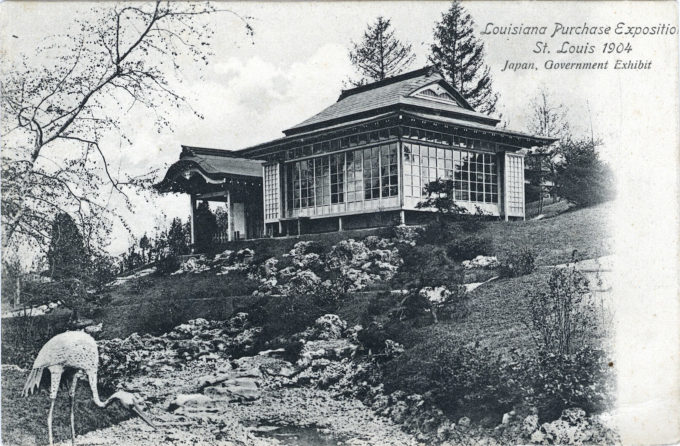
Japan Government Exhibit, Louisiana Purchase Exposition, St. Louis, Missouri (USA), 1904. The tea house and Japanese garden exhibit included a reception hall, and was one of several elaborate exhibits of the Empire of Japan on display at the world’s fair.
See also:
In the Japanese Gardens, Japan-British Exhibition, London (1910).
Japan Pavilion, Golden Gate International Exposition, San Francisco, CA, 1939.
“Beginning with the International Exposition, held at Vienna in 1873, and including the Louisiana Purchase Exposition, now open at St. Louis, Japan has already participated in twenty-seven World’s Fairs. Her participation in the present Exposition at St. Louis is more memorable in more than one respect than what she did at any preceding Exposition.
“In the first place, she has never before occupied such an extensive area of space for her exhibits as she does at the present occasion. It is twice and three times as large as that occupied by Japan at the Chicago World’s Fair of 1893, and that at the Paris Exposition of 1900, respectively. And in each department, where Japan takes any part at the present Fair, her location is almost ideal … Displays on an especially elaborate scale, however, can be found in the following eleven palaces — namely, Palaces of Education and Social Economy, Fine Arts, Liberal Arts, Manufactures, Varied Industries, Transportation, Mines, Forestry, Fish and Game, Electricity and Agriculture. The total area of space of the Japanese sections in these departments is approximately estimated at 129,457 square feet.
“Besides the above areas in the various departments, a splendid garden of a genuine Japanese style covers an extensive space of ground in which stand the Government building, and attached to it a reception hall and several other artistic mansions. Superb displays of Japanese garden and horticultural arts can be seen in this garden. With a grove of evergreens adjoining the east and south sides, and bordering on a broad thoroughfare at the front, the situation of the garden is almost ideal.
“In the Reception Hall just mentioned there are exhibited various data showing the growth and present status of the Red Cross Society of Japan in which the Empress takes a keen interest. The building materials for the Reception Hall, the office building and resting cottages have been brought all the way from Japan. The Reception Hall was built entirely by native carpenters, after a style of a Daimyo goten (palace of feudal lord) of some six hundred years ago. The architectural style of the building is what is termed Heike, a style prevailing at a time when a military family called the Heike held paramount power.”
– The Exhibition of the Empire of Japan: Official Catalogue, International Exposition, St. Louis, 1904

